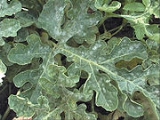
Sphaerotheca fuliginea
Encyclopedia
Sphaerotheca fuliginea is a plant pathogen that causes powdery mildew
on cucurbits. Sphaerotheca fuliginea and Erysiphe cichoracearum
are the two most commonly recorded fungi causing cucurbit powdery mildew. In the past, Erysiphe cichoracearum was considered to be the primary causal organism throughout most of the world. Today, Sphaerotheca fuliginea is more commonly reported .
Powdery mildew
Powdery mildew is a fungal disease that affects a wide range of plants. Powdery mildew diseases are caused by many different species of fungi in the order Erysiphales. It is one of the easier diseases to spot, as its symptoms are quite distinctive. Infected plants display white powdery spots on the...
on cucurbits. Sphaerotheca fuliginea and Erysiphe cichoracearum
Erysiphe cichoracearum
Erysiphe cichoracearum is a plant pathogen that causes powdery mildew disease of cucurbits, including melon, cucumber, pumpkin, and squash. The primary symptoms are white, powder-like spots on the leaves and stems. Sphaerotheca fuliginea causes a similar looking powdery mildew of cucurbits.-...
are the two most commonly recorded fungi causing cucurbit powdery mildew. In the past, Erysiphe cichoracearum was considered to be the primary causal organism throughout most of the world. Today, Sphaerotheca fuliginea is more commonly reported .

